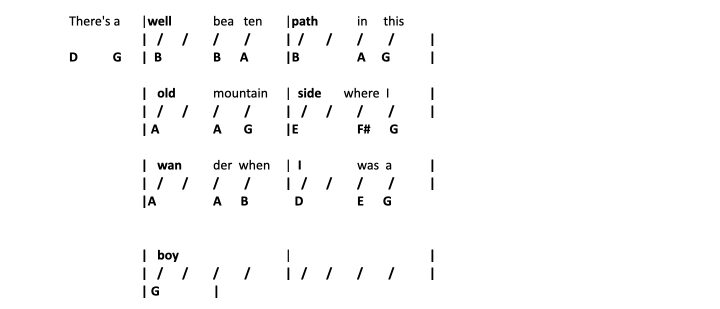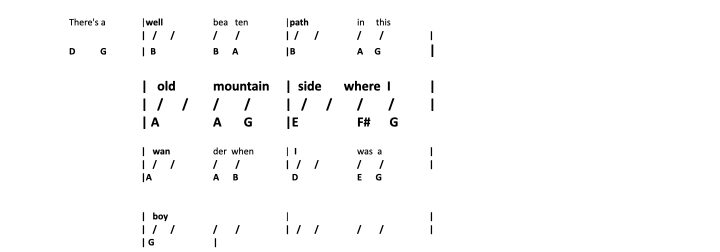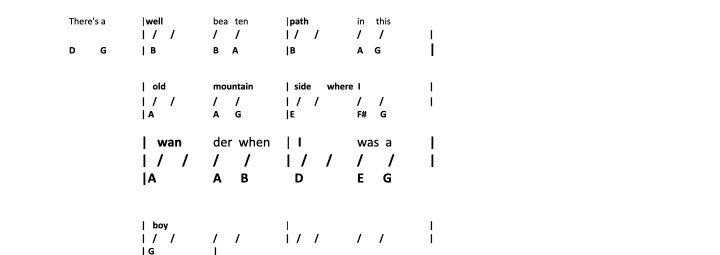Table of Contents
We are going to use the bluegrass classic Blue Ridge Cabin Home to illustrate how we can work out which chords to use , and where. This is the first verse, with the notes of the tune written underneath the lyrics. (Note these are not the chords, they are the notes of the tune !).
There’s a well beaten path in this old mountain side D G B B A B A G A A G E Where I wandered when I was a lad F# G A A B D E G G
We know we need to change chords somewhere, but we don’t know what chords to use or where to change. However, before we can do that, we need to know somethoing about Bars and Beats.
Bars and Beats
If we tap our foot (or clap) through ‘cabin home’ there are obvious strong points or beats, at different points in the tune – just try it ! Interestingly, in this song, the first strong beat isn’t on the first note, but on ’well’. (ThIs is known as ‘starting on an upbeat’ , a reference to conducting …).
There’s a well beaten path in this old mountain side …. D G B B A B A G A A G E
The other strong beats appear as shown below (e.g. on ‘well’, ‘path’, ‘old’, etc.)
There’s a well beaten path in this old mountain side Where I wandered when I was a lad
We can also feel other beats in between these, and if we mark where they come, there are three lesser beats between each main strong beat. We can feel that these beats are occurring at a regular speed.

Each group of Main and lesser beats is a bar or measure. The first bar is shown below. We refer to a tune in this rythym as being ‘in 4’, or ‘4 in a bar’.

When we write down chords and words for songs, there is a convention where the bar lines are written with a vertical line (e.g ”|) and the beats between the chords with a slash (e.g. ‘/’). So if we re-write Blue Ridge Cabin Home to show the bars and beats, it will look like this. (Note that the letters are still the notes of the tune, not the chords !).

Which Chord Where ?
So let’s start to put some chords in. We have helpfully been told that the tune is ‘in G‘, but what does that mean? It means that, for this performance the tune is being played in the key of G. If we remember the ‘scrabble bag‘ from the previous chapter (in the ‘Chords‘ chapter), then we will alos know that the main chords of that key (I, IV and V) are G, C and D.
If we don’t know the chords to a song, but we know what key it is in, then playing the home, or ‘root’ chord (chord I) at the beginning is always a good starting point. Our ears will tell us if this is wrong!. It’s not always the case, but a lot of times in Bluegrass and Americana, the song will start on chord I, the home or root chord.
First Line
If we just start playing a G chord, while this song is being sung, then it sounds fine for the first two bars, but when we get to ‘Old mountain Side’ it sounds wrong. If we look at the notes in the first two bars, we can see that these are either G, A or B. A chord have G contains a G – B – D, so it makes sense that the G and B notes in the tune will match the G chord, but why does the A not not sound wrong?
The notes on the main beats are G and B which strongly identifies a G chord. The A is a passing note – i.e. a note which is used to pass from one ‘chord’ note to another. The note A is one that we find in the key of G major, and therefore is a ‘valid’ passing note – just try using A flat in the tune instead – it sounds ‘wrong’
Second Line
Let’s look at the second line now. The G chord does sound right here, so the next step is to try one of the other main chords available to us in G major – the C and D. remember that C is chord IV (four) and D is chord V (five). If we look at the notes, we can see that the second line starts with an A, so it might seems sensible to try a D chord (which contains D – F# – A) but this doesn’t sound correct when we do that. Why not?

Our ears tell us that playing a D chord in the second line doesn’t sound correct, but if we play a C chord (the only remaining main chord in the song, then this sounds right. The second line contains the notes A, E, F# and G. Of these E and G are both found in the C chord, so that makes sense, but why does the A and the F# work?
Let’s look at the F# first. The clue is both where it is in the bar, and also what comes just before and after it. Its not on the main beat of the bar – that note is an E, which is both a strong note in the melody, and also on a strong beat in the bar (beat 1). It’s followed by a G, and both E and G are notes found in the chord of C. The F# is what we call a passing note – its a valid note in the key of G (its one of the notes in the ‘scrabble bag’), and because the tune only uses it very briefly, and passes quickly from and to notes in the chord that is being played, then it sounds perfectly correct.
The A note is a little harder to understand. Our ears tell us that it sound fine, but it seems to be a ‘wrong’ note – its not found in the chord of C (C – E – G). The answer is again what comes before and after it. The previous note is a G, and when we get to the A, our ears tell us that the chord needs to change. If the tune just continued with an A, then the C chord wouldn’t work – but because the A is followed by both a G and and E, which is on a very string beat, then the C chord works. ThIs is known as a resolution – this is where a note that is ‘wrong’ moves to one that is ‘correct’. It’s one of the reasons why the melody sounds so good – it’s all about the interaction between the melody and the underlying chords.
As an experiment, try singing and playing Blue Ridge Cabin Home, but singing a G note instead of an A at the start of the second line. It ‘works’ but sounds flat and lifeless. When we sing the A instead, it sound more lively, and the temporary clash resolves
Interestingly, playing a A against a C chord gives what is known as a C6 chord, which is something often found in jazz, where the chords are enhanced to make them sound more interesting.
Third Line

If we continue to play a C chord on the third line, then again it doesn’t sound right, but if we try the remaining chord (a D chord) then it sounds correct. If we look at the notes on beats 1 in the third line, we can see both and A and a D, which appear in the chord of D (D – F# – A). The other notes on that line are not in the chord, but again, as in the previous line, they are passing notes.
The final line only has a G note, and we return to the G chord to end the verse. THis sounds right, and is perfectly understandable, as we are finishing on the home chord.
Writing It Down
There are various ways of notating the chords for songs and tunes in bluegrass. This is covered in more detail in the Notation chapter, but the following is one of the mopst common ways of wtrting downo the chords.

You can see that the chord is written in the position in the bar where it changes, and then where the chord stays on the beat, the / character is used.
Summary
- A song (or tune) is a melody, played in a rhythm, which is broken up into beats and bars.
- The notes in the melody copme from the nlotes avaialble in the key (the ‘scrabble bag’)
- The notes in the melody indicate which chords will fit against it. Some of the notes will be notes from the chord, and others will be passing notes
Most importantly, our ears will tell us which chords work and which don’t. As a starting point
- Use chords I, IV and V (one, four and five)
- When you get to a point wehre one of these doesn’t sound right, try one of the others
Note – in the example here we have used a song which only uses chords I, IV and IV, and there are many Bluegrass, Folk and Americana songs and tunes only use these three chords. There are also many songs and tunes that use other chords from the key, and these are dealt with in another chapter (Beyond I – IV – V). However a knowledge and understanding of the three main chords is important, as is the technique to work out which chord goes where.